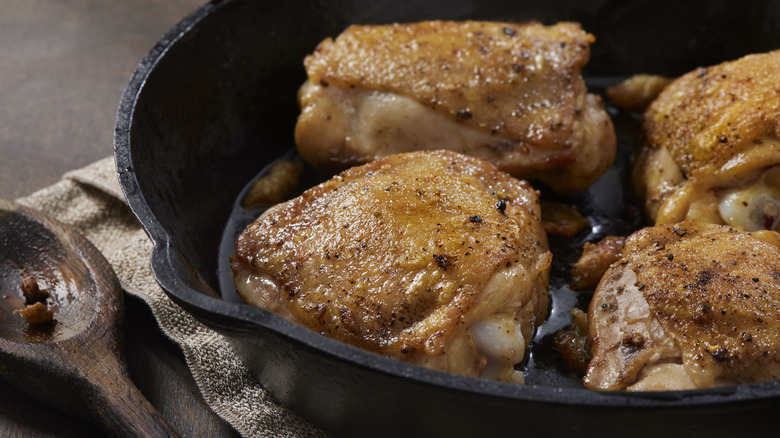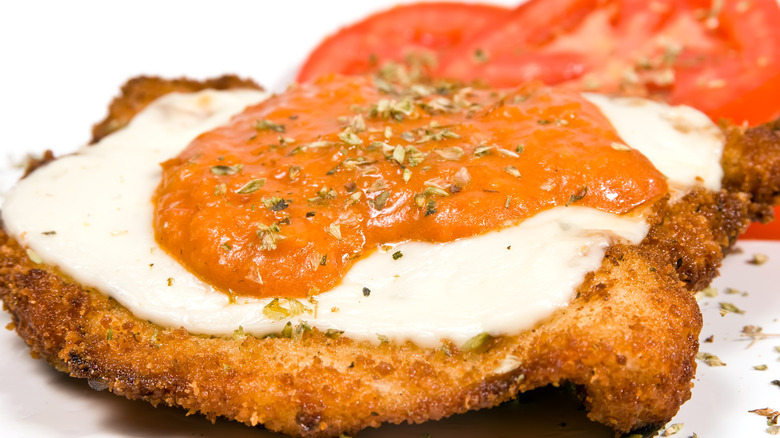Ina Garten's Sauce Tip To Stop Chicken From Getting Soggy
Chicken is the most consumed meat in the U.S. (according to Statista), and it's also arguably one of the most versatile proteins to prepare. Chicken can be part of a lean, healthy meal that many feel good about eating when grilled — and it's an irresistible indulgence when deep fried. Per capita, we consume almost 100 pounds of it annually, which is only projected to increase in the coming years.
For those of us who like the lean protein but don't want to eat it plain and grilled all the time, recipes like chicken Parmesan, marsala, and piccata offer the best of both worlds, adding texture and sauce to the otherwise standard meal. The problem with these multi-step recipes, however, is that you often spend half the time developing a delicious crust on the meat only to ruin the texture immediately when you add the sauce.
To prevent crispy skin or golden brown breading from getting soggy, Ina Garten has a smart trick — rather than pour sauces directly onto the chicken, the Barefoot Contessa instead spreads liquids around the meat, circling the cookware. Not only does this preserve the poultry's crispy texture, but it prevents washing away all the flavorful seasoning from the top of the chicken, too.
Tips for preventing soggy chicken skin
It's essential to crisp the chicken skin before even thinking about adding a sauce using Ina Garten's tip. That's because, once any liquids are introduced, you will have lost your opportunity to render the fat and add texture to the dish. Skin-on chicken is not only more flavorful, but the skin protects the meat from drying out as well. However, if the skin hasn't crisped, it can be an unpalatable chewy layer that ruins the dish.
To prevent soggy chicken, make sure the poultry is dry before cooking. Use paper towels to blot the skin, meat, and bones on each side. If you have the time, place the chicken uncovered in the refrigerator overnight as the circulating air will help to dry the exterior even further, making browning easier.
Before you add the meat to the pan, also ensure the cooking tool is preheated and the surface is very hot. The bird should sizzle as it enters the skillet, skin side down. Don't crowd the pan either, as this promotes steam, and avoid playing with the meat until the surface is golden brown and easily releases from the pan.
Once the meat is flipped, it's safe to pour wine or broth into the pan, as Garten suggests, avoiding pouring it directly on the chicken. To prevent steam from forming in the pan, avoid covering the dish, which will trap moisture that will speed up turning the skin soggy.
Tips for keeping breaded chicken crispy
Moisture is also the enemy of crunchy skin, too; however, it's a necessary component of sauces, so the trick is to figure out how they can coexist harmoniously. Part of the solution involves reimagining how to prepare classic recipes.
For chicken recipes like parmigiana that are breaded and fried, start with panko instead of the packaged plain or Italian seasoned breadcrumbs. Regular store-bought breadcrumbs have a finer texture and absorb more oil than panko. Panko breadcrumbs are airier and flakier, creating a crispier texture. They can be purchased plain or seasoned.
Instead of bathing crispy chicken in sauce, compose the dish differently, too. Consider chicken parm again, a chicken cutlet traditionally layered with sauce and melted cheese. But, to preserve the crunchy coating, don't bake the chicken and tomato sauce together. Rather, place the fried chicken and cheese in the broiler for a minute to melt the cheese, and assemble the dish by layering the tomato sauce on top — or around the dish, like Ina Garten does. Reversing the order of the ingredients still gives you the familiar taste you love but prevents the chicken from getting soggy.
Those who prefer a saucier dish can place a pool of sauce on the plate and top it with the chicken. The breadcrumbs will eventually absorb the liquid, but chances are you'll be on your last bite before that happens.



